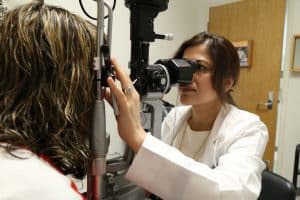Artificial Cornea Procedure Restores Arkansas Woman’s Vision
| Aug. 5, 2016 | An artificial cornea procedure, offered at UAMS Harvey & Bernice Jones Eye Institute, has allowed Jessica Ferguson to see again.
Ferguson, 28, was working with bleach at a salon in 2006 when a chemical burn occurred that would alter the next several years of her life.
“I put the bleach in a bowl, it was a powder, and it got into the air. I felt it get in my eye and tried to get it out, I thought I had,” said Ferguson. “I rubbed my eye throughout the day and it just got worse and worse.”
She dealt with eye problems prior to the incident, including retinal degeneration, but this was something much worse. Her vision deteriorated far beyond the legally blind threshold of 20/200, reaching depths of 20/400.
“I couldn’t make out any faces, I couldn’t see my kids,” she said. “If I went for a walk with them, I had to ask them if it was OK for us to cross the road.”
After years of managing the condition by different ophthalmologists, including cornea specialists, Ferguson was referred to Sunali Goyal, M.D., an ophthalmologist at JEI.
Goyal, also an assistant professor in the Department of Ophthalmology in the College of Medicine, provided a treatment avenue previously unavailable in Arkansas.
Goyal is one of a few ophthalmologists in Arkansas to provide surgery for Boston Keratoprosthesis, the most widely used artificial cornea in the world and a treatment option for patients who are not responsive to a traditional corneal transplant. These include patients with corneal disease, an autoimmune disease or chemical burns.
She trained under Claes Dohlman, M.D., Ph.D., creator of the procedure, during her fellowship in cornea and external diseases at the Massachusetts Eye and Ear Infirmary at Harvard Medical School in Boston.
The procedure was done on Ferguson’s right eye in February. The artificial cornea is made from a donor corneal graft arranged between titanium plates.
The donor cornea was provided by the Arkansas Lions Eye Bank & Laboratory at JEI, which provides, prepares and delivers eye tissue to transplanting surgeons all over the state and occasionally across the country and around the world.
Since the procedure, she’s back to work as a cosmetologist and has 20/70 vision in her right eye, the same as before the accident. There’s also a possibility she could have the procedure done in her left eye in the near future.
“I can go on walks by myself, I can help the kids with their homework, I can play with them outside,” she said. “It’s given me my independence back.”
Because the procedure requires so much post-operative attention, Goyal said it’s previously been difficult for people like Ferguson to seek treatment without incurring large travel expenses that many of them cannot afford.
“Many were forced to live with their condition unless they lived near a medical center that offered the service,” said Goyal. “It shows the tremendous passion for the health of all Arkansans at the Jones Eye Institute and UAMS for this procedure to now be offered.”
Ferguson said she would recommend Dr. Goyal and the procedure to anyone dealing with eye issues like hers.
“This was a lifesaver for me,” she said.

